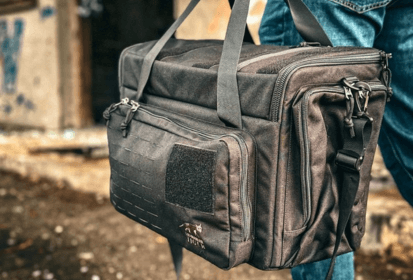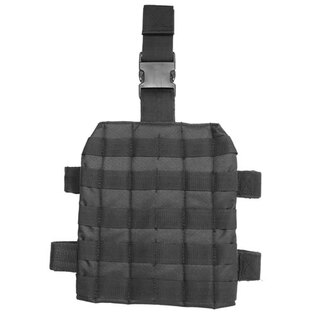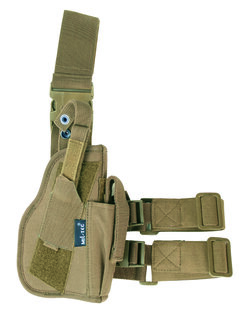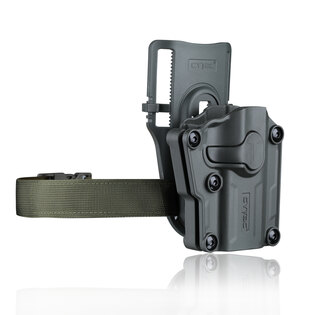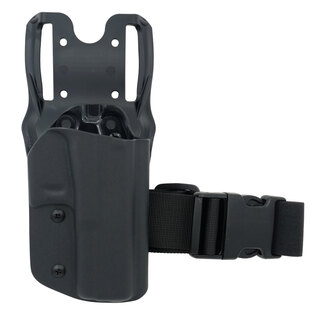How to Choose a Thigh Platform (A Pro’s Guide)
A thigh platform (drop-leg holster) solves problems that arise when a belt-mounted holster clashes with a plate carrier, side plates, or bulky pockets. It enables a clean, repeatable draw and better access while seated or driving. Because it also introduces trade-offs in movement, stability, and weight, it’s worth knowing when and how to use it—so it remains a functional tool, not a burden.
When—and Why—to Use a Thigh Platform (Drop-Leg Holster)
A thigh platform isn’t “another pocket”—it’s a targeted solution for scenarios where belt or chest rigs interfere with a fast, safe, and consistent draw. The main job is clearance: creating unobstructed space to draw even when torso or belt-line kit gets in the way—common with plate carriers, side plates, or oversized pouches.
✅ Situations Where a Thigh Platform Helps
- Clearance from kit: resolves interference with side plates, large pockets, or an IFAK at the lumbar.
- Comfort while seated/driving: enables drawing without stripping gear or fighting the belt line.
- Consistent presentation: preserves draw angle and path across outerwear (jackets, vests).
- Role-specific practicality: K-9 handlers, drivers, and armored configurations—any context where belt/PC setups block access.
⚠️ When a Thigh Platform Loses Its Value
- You need storage, not access: if the goal is carrying more stuff, use the belt or PC.
- Highly dynamic movement: low ride height or heavy loads cause swing, noise, and slower re-holstering.
- Speed reloads are critical: magazines on the thigh are slower and less consistent than belt/PC.
- Hostile environments: mud, frequent kneeling, and impact risk—e.g., a primary IFAK on the thigh is operationally sub-optimal.
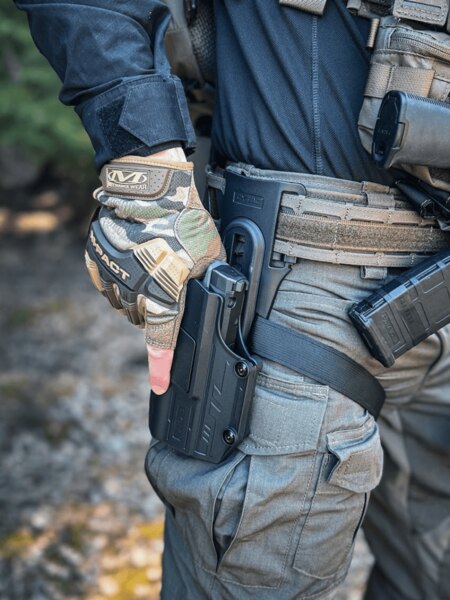
Modern configuration: holster attached to the belt with one stabilizing strap around the thigh. Active retention prevents the weapon from being released during movement and allows controlled drawing.
Types of Thigh Platforms and Current Design Trends
Modern platforms vary by panel size and attachment. Older designs favored large panels with two thigh straps. Current trends lean toward more compact, lighter, and more stable solutions with better ergonomics and less pendulum effect.
Classic Drop-Leg Panels
The traditional “full drop-leg” uses two thigh straps plus an upper hanger to the belt. A typical example is the Tasmanian Tiger® Leg Base, a robust CORDURA® 700D MOLLE panel. With three adjustable straps and rigid MOLLE fields, it provides a stable base for a pistol holster, mag pouches, and accessories.
This build is durable and flexible—it carries heavier loads and survives extended field use. Downsides: bulk and greater tendency to sway, especially if worn too low or overloaded. It’s best for specific tasks where immediate access to moreequipment is essential.
Modern Mid-Ride & Low-Ride Configurations
Ergonomically, the minimalist approach now dominates: a holster mounted directly to the belt with height adjustment(mid-ride or low-ride) and a single slim stabilizer strap around the thigh. This reduces sway and weight while preserving clearance below the belt line or plate carrier.
Mid-/low-ride is a balanced compromise between stability and speed. Properly set, it keeps the pistol close to the body’s center of mass, allows natural movement while running or kneeling, and avoids conflict with torso gear. That’s why many military and law-enforcement users prefer it for quick access, low profile, and durability.
💡 Field takeaway: Full drop-leg panels (e.g., TT Leg Base) = maximum capacity and versatility, but bulkier. Mid-/low-ride = lighter, more mobile, less sway. Match the choice to the mission or discipline—the more dynamic the movement, the smaller the panel should be.
Retention and System Setup
A quality thigh platform must secure the pistol and allow an immediate, fluid draw. That’s the role of retention—preventing unintended release during running, falls, or contact. Without solid retention, a drop-leg becomes self-defeating: the holster wobbles, draw angle shifts, and risk of poor grip or weapon loss increases.
Two core approaches:
- Passive retention: relies on precise molding and friction. Fast and simple, but less ideal for intense movement or physical contact.
- Active retention: uses mechanical features (hoods, latches, levers) that lock the pistol and require a specific motion to release. More secure, but it demands reps to keep the draw consistent.
Modern systems also benefit from modular mounts. Quick-detach/quick-locking interfaces let you move a holster between belt, thigh panel, or vehicle mount without tools. They add flexibility—but require regular inspection of screws and locks; a loose interface can release the entire assembly.
Rule of thumb: the pistol must not budge on its own, yet must release with one smooth, trained motion. After setup, test while moving—walk, run, kneel, and draw with gloves. Fine-tune angle and resistance to your kit and habits.
💡 Summary:
- Passive = fastest draw, less security in hard movement.
- Active = higher security, requires practice.
- Modular = flexible, inspect regularly.
- Proper tuning = safe, repeatable draw.
What (Not) to Run on a Thigh Platform — The Minimum-Load Rule
A thigh platform isn’t a storage shelf. Apply minimum-load: mount only what you truly need immediately and what doesn’t hinder drawing, running, or maneuvering. Overloaded panels increase noise, swing, fatigue, and the chance of a bad grip on the draw.
✅ Belongs on the Thigh
- Pistol holster—when thigh carry is tactically justified (plate-carrier clearance, seating/driving comfort). Use robust retention and set an angle that matches a natural grip.
- Slim TQ holder or narrow utility pouch—compact, low-profile items that don’t intrude on the draw. A quickly removable tourniquet can be acceptable as a contingency if the main IFAK isn’t immediately reachable.
- Very slim admin sleeve—for a map, ID, or a small multi-tool, only if it truly aids efficiency and stays clear of the pistol.
🚫 Keep Off the Thigh
- IFAK / full med kit—should be reachable with either hand and protected from impacts/contamination. Primary placement is on the PC/cummerbund or belt. The thigh is impact-prone, muddy, and often one-hand-limited.
- Stacks of magazines—belong on the belt or PC for speed and consistency. Reloads from the thigh are slower and less ergonomic.
- Heavy or bulky items—shift the center of gravity, hinder running, kneeling, and re-holstering, and increase fatigue.
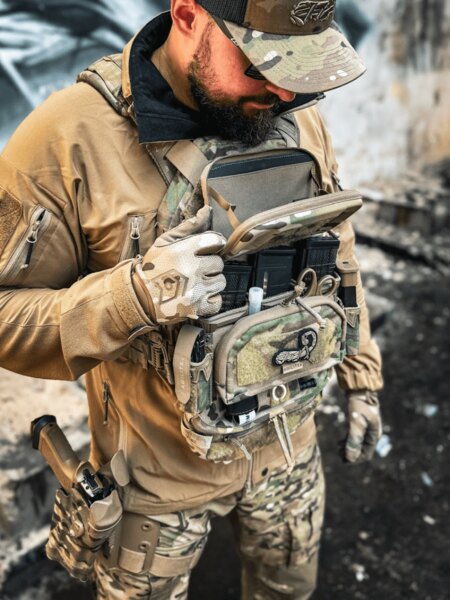
Chest carrier with an administrative or medical pouch within two-handed reach. The thigh holster complements the carrying system and allows for a clear draw under the gear.
Nuance & Exceptions
There are edge cases: if absolute torso clearance is required and nowhere else is safe for medical essentials, a slim thigh IFAK (TQ, hemostatic gauze, pressure dressing) can be justified—but only as a deliberate, SOP-driven exception with understood risks.
Similarly, one backup magazine on the thigh can be workable in unusual layouts (oversized side pockets, atypical belts). Primary, speed-critical mags should still live on the belt or PC.
Height, Cant, Stability, and Setup — A Quick Guide
Correct placement decides whether the platform helps or hinders. Follow these principles and confirm your adjustments under real movement—that’s when flaws show up.
Key principles
- Height: position the top edge of the panel just below the belt or plate carrier—never down by the knee. Low panels swing more and slow the draw.
- Cant: set the angle to keep the wrist neutral throughout the draw. Avoid forcing the hand into an awkward bend.
- Strap tension: tighten “one-finger snug”—firm without constricting. Straps must prevent panel shift without impeding circulation or irritating nerves.
- Anti-slip backing: rubberized backs increase stability, letting you run slightly looser tension without losing control.
- Weight & stability: the thigh is a moving lever—every extra gram multiplies fatigue and oscillation. Don’t counterbalance by loading the other leg; shift kit to the belt or PC.
Practical checklist for setting up a thigh platform
✔ Choose the configuration: favor mid-ride/low-ride with a single stabilizer strap; reserve full drop-leg only when the loadout truly demands it.
✔ Placement: top of the panel just below the belt/PC—not near the knee.
✔ Straps: tighten one-finger snug and verify the platform doesn’t migrate.
✔ Retention & cant: set for a natural wrist line and a smooth, single-motion release.
✔ Movement test: walk, run, kneel, draw, and re-holster (with gloves). Tune until behavior is stable, quiet, and consistent.
💡 Tip: After each tweak, run a short, full-kit test—gloves on, real load, actual movements. That’s the only way to confirm it works beyond the mirror.
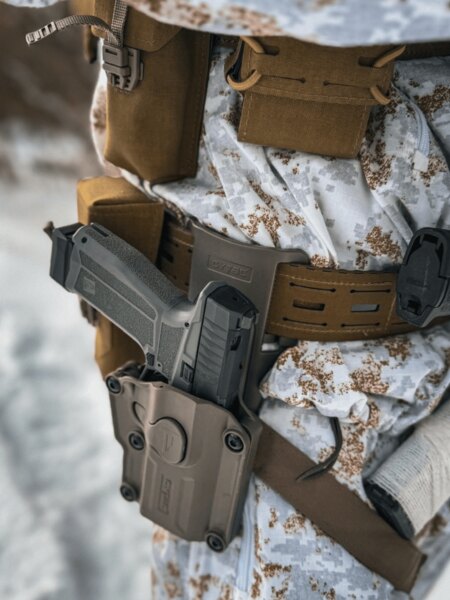
Low-ride solution: holster extended below the belt without a bulky thigh panel. Lower profile, less swinging, and quick draw even in bulky clothing.
Common Mistakes with Thigh Platforms
Most issues are easy to fix once you know what to look for:
🚫 Panel worn too low → sway & slow draw
A lower mount increases the lever arm between thigh axis and pistol—more swing, longer, less consistent draw stroke.
✔ Fix: move the panel’s top edge just below the belt/PC (mid-ride). Test at a walk and a run; fine-tune height.
🚫 Loose straps or weak retention → loss of control
Slack straps or poorly set retention let the panel move independently; the pistol shifts angle or can release.
✔ Fix: tighten straps one-finger snug, use anti-slip backing, set holster retention to secure but smooth—and test in motion.
🚫 IFAK on the thigh → poor access & damage risk
A primary med kit must be ambidextrous and protected. Thigh placement hurts access under stress and exposes it to impacts and mud.
✔ Fix: mount IFAK on PC or belt. If no alternative exists, use only a slim emergency module and document it in SOPs.
🚫 “Everything on the thigh” → clutter, noise, fatigue
Overloading with mags/tools/pouches breeds mess, asymmetry, and faster fatigue.
✔ Fix: apply minimum-load—keep only the holster and maybe one slim TQ/utility pouch. Move the rest to belt/PC.
Bottom Line — A Tool, Not a Complication
A thigh platform earns its place when belt or plate carrier setups block a natural draw. Used thoughtlessly, it becomes dead weight. The key is less is more: minimal load, correct height, solid attachment, and reliable retention. It should complement your load-bearing system, not replace it.
In practice: choose mid-ride/low-ride, one stabilizer strap, a quality retention holster, and little else. Test in motion and tune until the draw is smooth and repeatable. A thigh platform only makes sense if it lets you run the pistol more effectively—not if it adds another kilo to the part of your body that moves with every step.
Readers are further interested
